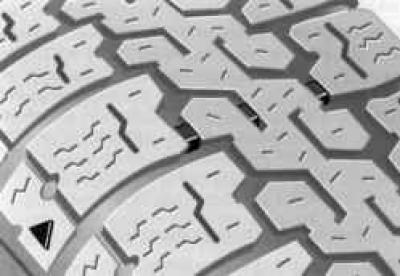Attention: Initially, new tires must be rolled in because they do not yet provide sufficient grip on the road surface; the first 500 km should be driven at a moderate speed and with extreme caution - during this period the tires roll in. Successful implementation of this process contributes to a longer tire life.
Check tires regularly for damage (punctures, cuts, tears and blisters). Remove foreign bodies from tire tread.
To avoid damage to tires and rims, drive over curbs and other similar obstacles slowly and as straight as possible.
Often tires and wheels have hidden damage. An unusual vibration or vehicle pulling to one side may indicate tire damage. If there is a suspicion that the tire is damaged, slow down immediately! Check tires for damage (cracks, blisters, etc.). If no external damage is found, drive slowly and carefully to the nearest Volkswagen dealer for a thorough check of the condition of the tires.
Avoid contact of tires with oils, greases and fuels.
Replace lost dust caps with new ones immediately.
Before removing the wheels, it is necessary to make appropriate marks on them so that when reinstalling, the same direction of rotation of the tires can be maintained.
Removed wheels and tires should be stored in a clean and dry condition, if possible in a cool and dark room.
Tires not mounted on rims should be stored upright.
Tire durability
Tire life depends mainly on the following factors.
Tire pressure.
The nominal air pressure values for summer tires are indicated on a sticker on the inside of the fuel filler cap; winter tires have a nominal air pressure of 0.2 bar more than summer tires.
It is especially important to maintain the recommended air pressure in the tires when driving at high speeds. Therefore, the air pressure in the tires should be checked at least once a month and before every long trip.
In this case, do not forget to measure the air pressure in the spare wheel:
The spare tire should always maintain its nominal pressure for a fully loaded vehicle.
The value of the nominal air pressure in the emergency wheel («spare wheel») indicated on the sidewall of the tire.
Tire pressure should always be checked when the tires are cold. With increased air pressure in hot tires, do not bleed air from the tire. If the load changes significantly, the air pressure in the tires should be changed accordingly.
You can attach a pressure gauge directly to the dust cap without unscrewing it.
Too low or too high tire pressure will shorten tire life and impair driving performance.
Tire wear indicators

Pic. 1.83. Tire wear indicators
In the grooves of the tread pattern of those tires that were installed on the vehicle at the factory, there are «tire wear indicators» 1.6 mm high, located at right angles to the direction of translation of the tire (pic. 1.83). These indicators range from six to eight (depending on the manufacturer) placed at equal distances around the circumference of the tire. Tire sidewall markers (e.g. letters «TWI» or an icon in the form of a triangle) show the location of the tire wear indicators.
Attention: Tires must be replaced at the latest when their tread is worn down to the wear indicators.
Attention: Worn tires do not provide the necessary traction, especially when driving at high speeds on wet roads. In addition, with worn tires, hydroplaning occurs much faster (loss of wet grip).
Changing tires and rims
Tires and rims (on disc wheels) are important building blocks of a vehicle. Therefore, tires and wheels purchased from us should be used. They will fully match your car, which in turn will ensure good vehicle stability and traffic safety.
Volkswagen service outlets provide detailed information on which tires and wheels to purchase. Many Volkswagen workshops have a wide selection of tires and rims.
Mounting and repairing tires requires special tools and professional skills. These works should only be carried out by professionals.
For reasons of traffic safety, if possible, change the tires not individually, but at least on the axles. Less worn tires should always be placed on the front wheels.
All four wheels should only have radial tires of the same design, same size (with the same circumference) and, if possible, the same design of the tire profile.
If the spare wheel tire is designed (e.g. winter tire or wide tire) differs from the rest of the vehicle tires, such a spare wheel should only be used for a short time in the event of failure of one of the vehicle's tires and with appropriate increased driving caution. Instead of such a wheel, a normal wheel should be installed again as soon as possible.
Never put a used tire on a car if you don't know where and how it worked before.
Reinstallation of wheels
In case of pronounced wear of the front wheels, it is recommended to swap the front wheels with the rear ones according to the diagram. As a result, all tires will have approximately the same service life.
For certain types of tire tread wear, it is advisable to swap the tires crosswise.

Pic. 1.84. Wheel alignment diagram.

Visitor comments